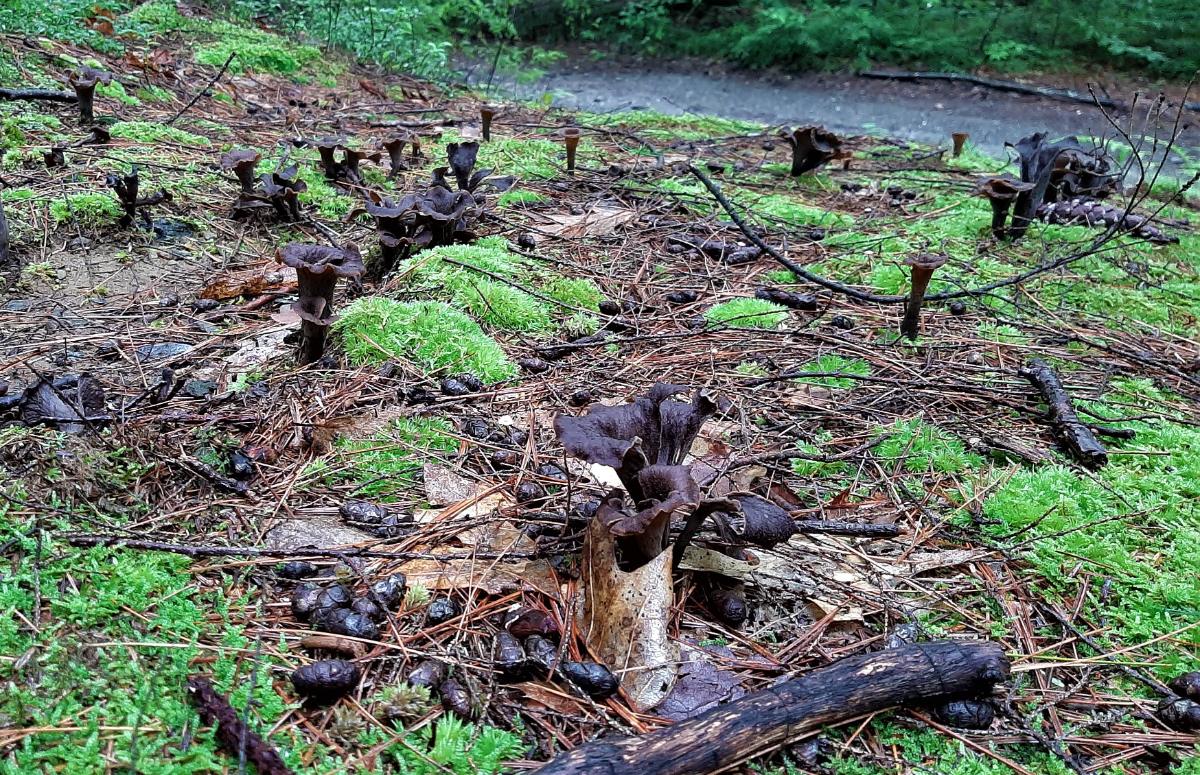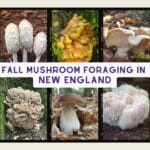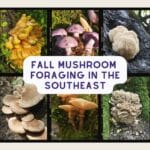The summer heat of the southeast is good for some mushrooms and too much for others. Summer mushroom foraging in the southeast has lots of potential, with chanterelles, puffballs, and black trumpets waiting to be discovered. You’ll have to contend with the heat, humidity, and crazy amounts of bugs, but it’s worth it to find these tasty edible mushrooms.
Make sure you’ve got some good bug and tick spray when you’re out foraging. We love these permethrin-treated socks (and other clothing)—they really work to keep the ticks away. Also, we don’t go in the woods without these mosquito head nets to protect our faces from the relentless mosquitos and black flies. They may look a little funny, but they’re totally worth it!

If this guide is missing any southeast summer mushrooms, please let me know in the comments. And make sure to check out the other Southeast foraging guides: Spring Mushroom Foraging in The Southeast, Fall Mushroom Foraging in the Southeast, and Winter Mushroom Foraging in The Southeast.
Jump to:
Summer Mushroom Foraging In The Southeast
Chicken of the woods
Everyone’s favorite and delicious chicken of the woods starts showing up in late spring and continues fruiting through summer and fall. This dense, meaty edible mushroom is one of the best for the dinner table, and also, it’s one of the easiest to identify. It also doesn’t follow a set fruiting schedule. Each individual fruiting seems to be on its own timeline, which can make it challenging to find reliably. But, if you do find one, make sure to mark the spot because it will return the following year.
There are a few species of chicken of the woods in the southeast. There is the classic bright orange to yellow variety, and there is also a lighter peachy-colored species. Both are edible and prime. Chicken of the woods grows in dense overlapping clusters on dead and dying wood.

This mushroom doesn’t taste like chicken, but it has a very similar texture. It’s excellent fried, sauteed with garlic and butter, barbequed, and stir-fried.
- Laetiporus sulphureus – bright orange to yellow cap and bright yellow pores.
- Laetiporus cincinnatus – peachy cap and white spores, almost exclusive to oak trees
- Laetiporus persicinus – salmon orange or white cap with white spores, turns brown quickly.
You can find all the details about the different species in this chicken of the woods guide.

Chanterelles
The bright, brilliant, golden gem of the summer forest for every mushroom hunter is the chanterelle. Chanterelles have a unique fruity scent and flavor and a dense texture. They’re a treat! Finding chanterelles takes a little searching, but luckily, once you find them, they’re usually in large, scattered, abundant patches. It’s easy to walk away with a good haul.

There are several species of chanterelles in the southeast. Some aren’t that golden yellow, so be sure to learn them all so you don’t miss out on this top edible mushroom species. Chanterelles can be confused with a few toxic mushroom species for those still learning mushroom foraging. Once you learn their characteristics, it’s difficult to mistake them for anything else because they are unique. But, a quick observation of it can lead to misidentification so be attentive.
- Cantharellus appalachiensis – Brownish yellow cap with similar colored false gills. Fruits with oaks and other hardwoods.
- Cantharellus confluens – Golden yellow cap, pale yellow underside. False gills are almost nonexistent, and the undersurface is very smooth. Grows in dense overlapping clusters instead of scattered.
- Cantharellus lateritius—This is known as the smooth chanterelle. Its undersurface is almost entirely smooth. The cap is golden yellow, and the undersurface is the same color.
- Cantharellus minor – A small chanterelle rarely getting more than 1.5 inches tall. It has an orange-yellow cap with false gills that are the same color.
- Cantharellus cinnabarinus – The red chanterelle ranges in color from bright orange to red to flamingo pink. It is small, averaging 1.5 inches tall.
- Cantharellus persicinus – A species of red chanterelle that grows in the Appalachian Mountains. It is peachy orange to salmon orange with false gills the same color as the cap.
- Cantharellus coccolobae – A red chanterelle that fruits in Florida, the Bahamas and the Caribbean in association with sea grape plants. It is pinkish orange to pink to red.
If you want to learn all about the different species and how to tell them apart, check out the Chanterelles of the US guide.

Black Trumpets
A cousin to the chanterelle, the black trumpet looks quite different but also has some family resemblance. Black trumpets are deep gray to black, trumpet-shaped, and smell rich and earthy. Their flavor is like no other species, which is why they’re so widely sought, even though there isn’t much to them.
Black trumpet mushrooms are notoriously delicate, with thin, fragile flesh that easily falls apart in a foraging bag. If you’re hunting these mushrooms, bring along a separate brown paper bag or basket for them, as they won’t survive in a basket with other mushrooms.
These edible mushrooms are a mid- to late-summer species and are tricky to find. Their dark caps blend right in with the forest duff, and they’re not very big, so they don’t stand out like chanterelles. Foraging these forest treats takes lots of patience, trekking through the woods, and careful study of the topography—or just plain luck!

Yellowfoot Chanterelles
You might notice the resemblance of yellowfoot mushrooms to chanterelles, and it’s because they are very closely related. Yellowfoot mushrooms grow in abundance in the Southeast and are decent edibles. They don’t taste nearly as good as their cousins; in fact, they’re rather bland. But because they appear in such vast fruitings and are so common, they are widely foraged.
The key to differentiating the yellowfoot mushroom from a chanterelle is the size and stem. Yellowfeet are small, like the the smallest chanterelle species, and they have a hollow stem. Chanterelles don’t have hollow stems.
This forager commonly finds yellowfoot chanterelles fruiting in the same area, if not at the same time and place, as black trumpets (another mushroom relation). So, whenever you see yellowfeet, check around for black trumpets. Black trumpets usually fruit just a little bit later (but not always), so make sure to check back a few times throughout the season to see if the trumpets show up in the same vicinity.

Lobsters
One of the most bizarre edible mushroom species, the lobster mushroom is actually the result of another fungi species being parasitized by this one. It’s a fantastic transformation that creates a highly sought-after wild edible mushroom. Lobster mushrooms are thick, dense, and have a slightly sweet flavor.
Some people say they taste like ocean lobster, but that is a trick of the mind based on visual similarity. They are delicious, but they don’t taste like seafood. They sure look like it, though!
Lobster mushrooms fruit throughout the summer, and they’re usually pretty easy to spot due to their brilliant red or orange coloring. The great thing about this species is that it tends to reoccur in the same place every year, so if you find them, be sure to mark the spot.

Hedgehogs
The adorable toothed hedgehog mushroom is sweet and nutty-tasting, with dense flesh. It is also pretty easy to identify due to its unique teeth under the cap, where most mushrooms have gills.
Many people miss out on foraging hedgehogs because, from above, they’re rather plain-looking and easily overlooked. The tan to buff-white cap of the hedgehog mushroom is lumpy, undecorated, and often blends in with the surroundings. This is why we stop to inspect every mushroom, even if it looks boring from above.
Hedgehog mushrooms are a treat in the kitchen. Cooking brings out their sweet nuttiness, and they are excellent in stir-fries, sauteed with butter and garlic, or added to soups and stews.

Puffballs
Puffballs big and small start showing up in summer. Finding a giant puffball is a treat but the smaller puffballs are also edible. You just have to forage a lot more to get a meal. Puffball mushrooms are among the easiest to forage because they are quite distinct looking. However, you do have to be careful with the small ones because there are dangerous lookalikes that resemble small puffballs when they’re babies.
Giant puffballs, on the other hand, are one of kind. Nothing else looks like someone left their volleyball sitting in the middle of a field! A foraged puffball will feed you for days. And, a lot of the time, more than one fruits in an area so you might end up with several of these monsters at once.
They’re not the best tasting mushroom, rather bland and airy in texture and flavor. But, they take on other flavors really well and can be used much like tofu. They also dehydrate really well and can be used to bulk up soups and stews.

Yellow Oysters
Most oyster mushrooms prefer the cooler weather of spring and late fall, but yellow oyster mushrooms are their own beast. They are not native to North America; they’re escapees from cultivation and, therefore, should be foraged with abandon! They aren’t exactly invasive – they aren’t causing any known harm (yet), but they aren’t native, so forage all that you see.
Yellow oysters, like gray oysters, are top edible mushrooms and delicious. They’re versatile in recipes and great in everything from stir-fries to soups to pizzas and, of course, fried. They have a light mushroomy taste that easily takes on other flavors without losing its own.

Tips For Summer Mushroom Foraging In The Southeast
- The best time to get out in the woods is 2-5 days after a good rain storm. This is when most mushrooms will fruit. If you wait too long, you’ll have to contend with slugs and bugs who are looking for a nice snack.
- Do not forget your bug and tick spray! Seriously, the tick situation is awful and shouldn’t be disregarded – it’s not a matter of if you will get ticks on you, but how many. But if you take the proper precautions and always do tick checks after being in the woods, you should be fine.

Other Summer Mushrooms In The Southeast
You’ll probably stumble across lots of russula and milky cap species. These two look quite similar, and both have edible varieties in them. They’re not included in this list because most of them, even if edible, aren’t that fantastic. Some are decent, but not compared to the prime edible species listed above.
There are also a lot of boletes starting to show up in the forest. Make sure you read up on the boletes before foraging them – they can be tricky, though thankfully, not super dangerous – just really bad tasting if you get the wrong ones.









Leave a Reply